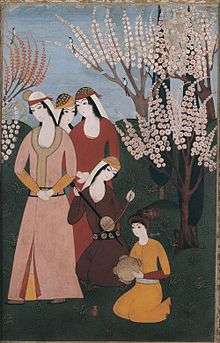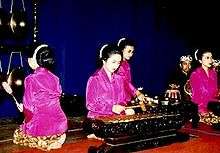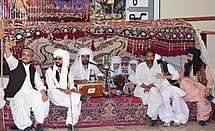Islamic music
Islamic music may refer to religious music, as performed in Islamic public services or private devotions, or more generally to musical traditions of the Muslim world. The classic heartland of Islam is the Middle East, North Africa, the Horn of Africa, Iran, Central Asia, and South Asia, and it also included the medieval Iberian peninsula (al-Andalus). Due to Islam being a multi-ethnic religion, the musical expression of its adherents is vastly diverse. Indigenous traditions of various part have influenced the musical styles popular among Muslims today.
| Part of a series on |
| Islamic studies |
|---|
| Jurisprudence |
| Science |
| Arts |
| Architecture |
| Other topics |
Secular and folk musical styles

Middle East
- Arabic music
- Egyptian music
- Iranian music
- Turkish classical music
All of these regions were connected by trade long before the Islamic conquests of the 7th century, and it is likely that musical styles travelled the same routes as trade goods. However, lacking recordings, we can only speculate as to the pre-Islamic music of these areas. Islam must have had a great influence on music, as it united vast areas under the first caliphs, and facilitated trade between distant lands. Certainly, the Sufis, brotherhoods of Muslim mystics, spread their music far and wide.
North Africa
The Berber and Arabic speaking countries of North Africa, such as Morocco, Algeria, and Tunisia, share some musical traditions with Egypt and the Arab countries of the Middle East. Popular modern styles of music such as Raï and Chaabi originated in Berber counties. In addition, West African influences can be heard in the popular music of Gnawa.
Horn of Africa

Most Somali music is based on the pentatonic scale. That is, the songs only use five pitches per octave in contrast to a heptatonic (seven note) scale such as the major scale. At first listen, Somali music might be mistaken for the sounds of nearby regions such as Ethiopia, Sudan or Eritrea, but it is ultimately recognizable by its own unique tunes and styles. Somali songs are usually the product of collaboration between lyricists (midho), songwriters (lahan), and singers ('odka or "voice").[1] Instruments prominently featured in Somali music include the kaban (oud).
West Africa
Islam is the largest and oldest organized religion in this region, although indigenous Sahelian and Saharan styles and genres are more prominent than those influenced by Middle-Eastern theory.
West African musical genres are more varied, and tend to incorporate both native and Berber influences, rather than those of Arab origin. A long history of court griot music based on historical accounts and praise-singing exists in the region. Wind and string instruments, such as the Kora harp, xalam lute, or Tambin flute (similar to the ney) are generally preferred to percussion, although percussion instruments such as the talking drum and djembe are also widely played among Muslim populations
Central Asia
Many of the countries in Central Asia such as Uzbekistan, Tajikistan and Turkmenistan have been heavily influenced by Turkic and Persian culture. Bowed instruments are common, as is bardic singing.
South Asia
The music of the Muslim countries of South Asia (Bangladesh, Maldives and Pakistan) as well as countries with sizeable Muslim minorities (India, Nepal and Sri Lanka) merged Middle Eastern genres with indigenous classical musical modes, and is generally distinct in style and orchestration, yet due to the strong links encountered between the Middle-East, Central Asia, and South Asia, it is closer to Middle-Eastern styles than those of the periphery of the Islamic world, which tend to be purely indigenous.
- Music of Bangladesh
- Music of Maldives
- Music of Pakistan
Southeast Asia

Muslim-majority Indonesia has been significantly less influenced by Middle Eastern traditions than South Asia. As a result, many local musical styles predate the coming of Islam, although exceptions include Malay Zapin and Joget, and the Indonesian Gambus, all of which show strong Middle Eastern influence.
There are also local music genres in Muslim-majority regions in Southeast Asia that are influenced by Arabian traditions, such as the tagonian of the Sundanese people and glipang of the people of Probolinggo
The music of South East Asia's Muslim-majority regions is more closely related to the musical genres of South East and East Asia. Gong chime ensembles such as Gamelan and Kulintang existed in the region before the arrival of Islam, and musical theory and method owe more to heavy Chinese influence, as well as Hindu-Buddhist principles, than to Arabic musical philosophy. Variations of one of two main scales prevail in the region among different ensembles: slendro and pelog (both of which originated in Java).
In Java, use of the gamelan for Islamic devotional music was encouraged by the Muslim saint Sunan Kalijogo.
Types of Muslim devotional recitation and music
Nasheed
Nasheeds are moral, religious songs sung in various melodies by some Muslims of today without any musical instruments. However, some nasheed groups use percussion instruments, such as the daff. Singing moral songs of this type without instrumentation is considered permissible (halal) by many Muslims. Some famous nasheed singers are Native Deen, Outlandish, UNIC and Raihan. Other well-known artists are Ahmed Bukhatir, Yusuf Islam (formerly known as Cat Stevens), Ahmed Mac, Sami Yusuf, Junaid Jamshed, Zahid Ullah Afridi, Maher Zain, Harris J, Hamood ul khuder, Hamza Namira, Raef, Jae deen (Deen squad), Mesut Kurtis, Dawud Wharnsby, Zain Bhikha.
Sufi music
Sufi worship services are often called dhikr or zikr. See that article for further elaboration.
The dhikr of South Asian Muslims is "quietist". The Sufi services best known in the West are the chanting and rhythmic dancing of the whirling dervishes or Mevlevi Sufis of Turkey.
However, Sufis may also perform devotional songs in public, for the enjoyment and edification of listeners. The mood is religious, but the gathering is not a worship service.
In Turkey, once the seat of the Ottoman Empire and the Caliphate, concerts of sacred song are called "Mehfil-e-Sama' " (or "gathering of Sama'"). Song forms include ilahi and nefe.
In South Asia, especially Bangladesh, Pakistan and India, a widely known style of Sufi music is qawwali. A traditional qawwali programme would include:
- A hamd—a song in praise of Allah
- A na`at—a song in praise of Muhammad
- Manqabats—songs in praise of the illustrious teachers of the Sufi brotherhood to which the musicians belong
- Ghazals—songs of intoxication and yearning, which use the language of romantic love to express the soul's longing for union with the divine.
Shi'a qawwali performances typically follow the naat with a manqabat in praise of Ali, and sometimes a marsiya, a lamentation over the death of much of Ali's family at the Battle of Karbala.
The most well-known qawwali singer in modern times is Nusrat Fateh Ali Khan.
Another traditional South Asian genre of Sufi music is the Kafi, which is more meditative and involves solo singing as opposed to the ensemble form seen in qawwali. The most widely known exponent of the Kafi is the Pakistani singer Abida Parveen.
Sufi music has developed with the times. A Pakistani Sufi rock band, Junoon, was formed in the 1990s to bring a modern twist to suit the new younger generation. The band achieved wide popularity, in Pakistan as well as in the West.
Music for public religious celebrations
- Ta'zieh music—Ta'zieh is a passion play, part musical drama, part religious drama, rarely performed outside Iran. It depicts the martyrdom of Imam Hussein, venerated by Shia Muslims.
- Ashurah music—performed during the Muharram mourning period, commemorating the deaths of Imam Hussein and his followers. (Shia)
- Thikiri (from the Arabic word "Dhikr" which means remembrance of God—performed by the Qadiriyya Sufi orders of waYao or Yao people in East and Southern Africa (Tanzania, Mozambique, Malawi, Zimbabwe, and South Africa).
- Manzuma—moral songs performed in Ethiopia.
- Madih nabawi—Arabic hymns praising Muhammad.
Modes
- Arabic Maqam
- Dastgah
Instruments
Some Muslims believe that only vocal music is permissible (halal) and that instruments are forbidden (haram). Hence there is a strong tradition of a cappella devotional singing.
Yet some Muslims believe that any instrument is lawful as long as it is used for the permissible kinds of music. Hence there is a long tradition of instrumental accompaniment to devotional songs. A wide variety of instruments may be used, depending on local musical traditions.
Traditional:
- Drums (daf, bendir, zarb, rebana...)
- Gongs
- Lute or oud
- Wind instruments (ney...)
- Reed instruments (shehnai...)
Recent introductions:
- Harmonium (popular in Pakistan and India)
Lyrics
When lyrics are not simply repeated and elaborated invocations (Yah Nabi and the like), they are usually poems in forms and meters common in the local literature.
Permissibility of music
The question of permissibility of music in Islamic jurisprudence is historically disputed.[2] Imam al-Ghazzali, one of the most famous Muslim scholars, writing almost a thousand years ago, reported several hadith and came to the conclusion that music is permitted, saying: “All these Ahadith are reported by al-Bukhari and singing and playing are not haram.”[3] But majority of scholars interpret the chapters of Luqman and Al-Isra in the Quran as evidence that music is haram,[4] although this is disputed by others who disagree.[5]
Those who do not allow music believe that Muhammad censured the use of musical instruments when he said: "There will be among my Ummah people who will regard as permissible adultery, silk, alcohol and musical instruments".[6] Those who argue that music is halal (permitted) state that this hadith relates to usage—at the time the polytheists used music and musical instruments as part of their worship- and does not apply to all music.[3] They also point out that in the Quran, it is stated that Hazrat Dawud was given the Psalms.[7] (an-Nisa, 4/163; al-Isra, 17/55). In other Islamic resources, it is stated that the Psalms given to Hazrat Dawud were sent down in the month of Ramadan, that it contained sermons and words of wisdom and that Hazrat Dawud usually recited it accompanied by a melody and a musical instrument;[8] therefore music is permitted. Supporters of this view also point out that in classical Islamic jurisprudence and Sharia, the Quran is the higher authority on correct Islamic practice; the hadith, while important, are secondary to the Quran. [9]
Those who saw the permissibility of music include some of the most famous Muslim scholars, jurists, philosophers, and Sufi poets of the Muslim world, including Abu Bakr ibn al-Arabi, Ibn al-Qaisarani, Ibn Sina, Abu Hamid al-Ghazali, Rumi, Ibn Rushd, and Ibn Hazm. Al-Ghazali also reports a narration from al-Khidr, where he expressed a favorable opinion of music, provided it be within the usage limitation of virtuous areas.[10][11] Al-Ghazali has been referred to by some historians as the single most influential Muslim after the Islamic prophet Muhammad.[12]
Certain schools of Sunnis as well as some Shiites hold that music is forbidden with the sole exception being that women can play the Daf, a traditional one sided drum, at celebrations and festivals.[13] However some Islamic groups and denominations deem music permissible including many Sufi orders who use music as part of their worship.[14]
According to some authorities, Islam does allow singing without musical accompaniment within prescribed circumstances—namely that the performer be of the same gender as the audience;[15] there is a well-known hadith in which two small girls were singing to a woman[16], and the Prophet Muhammad instructed Abu Bakr to let them, stating, "Leave them Abu Bakr, for every nation has an Eid (i.e. festival) and this day is our Eid.".Sahih al-Bukhari, 3931 Sahih al-Bukhari, Vol. 5, Book of Merits of Al-Ansaar, Hadith 268 Sahih al-Bukhari, Book of Merits of Al-Ansaar, Hadith 268 [17] Others hold that music is permitted in Islam provided that the lyrics are not obscene or vulgar.[15]
Iran
Based upon the authentic Shia ahadith, numerous Iranian Grand Ayatollahs; Sadiq Hussaini Shirazi, Mohammad-Reza Golpaygani, Lotfollah Safi Golpaygani, Mohammad-Taqi Mesbah-Yazdi, Ahmad Jannati and others, ruled that all music and instrument playing is haram, no matter the purpose.[18][19][20] Grand Ayatollah Ruhollah Khomeini held similar religious position, stating on 23 July 1979: “If you want independence for your country, you must suppress music and not fear to be called old‐fashioned. Music is a betrayal of the nation and of youth.”[21] During the Iranian Revolution, Khomeini said: "...music is like a drug, whoever acquires the habit can no longer devote himself to important activities. We must completely eliminate it."[22] From 1979-1989, all the music on radio and television was banned except occasional “revolutionary songs” that were performed in a strong martial style.[23] After Khomeini’s death, reformist Rafsanjani and Khatami administrations gradually lifted the ban on music. The current supreme leader of Iran, Ali Khamenei, in 2014 has stated his admiration of Western music,[24] and nowadays music is officially permitted in Iran by the government as long as it is either Iranian folk music, Iranian classical music, or Iranian pop music.[25]
Contemporary Islamic music
Notable nasheed artists include:
- Ahmad Hussain – United Kingdom
- Ahmed Bukhatir – United Arab Emirates
- Abu Ratib – Syria
- Dawud Wharnsby – United States
- Haddad Alwi – Indonesia
- Syech bin Abdul Qodir Assegaf - Indonesia
- Hamza Robertson – United Kingdom
- Imad Rami – Syria
- Junaid Jamshed – Pakistan
- Maher Zain – Sweden
- Mecca2Medina – United Kingdom
- Mesut Kurtis – United Kingdom
- Mishary Rashid Alafasy – Kuwait
- Muslim Belal – United Kingdom
- Native Deen – United States
- Nazeel Azami – United Kingdom
- Raef – United States
- Raihan – Malaysia
- Sami Yusuf – United Kingdom
- Yahya Hawwa – Syria
- Yusuf Islam – United Kingdom
- Zain Bhikha – South Africa
- Hamza Namira - Egypt
Notable Sufi singers include:
- Nusrat Fateh Ali Khan – Pakistan
- Abida Parveen – Pakistan
- Sabri Brothers – Pakistan
- Munshi Raziuddin - India
- Fareed Ayaz - Pakistan
- Alam Lohar – Pakistan
Noted composers:
- A. R. Rahman – India
- Resul Pookutty- India
- Rohail Hyatt - Pakistan
- Harris J - United Kingdom
See also
- Durood
- Hamd
- Islamic poetry
- Mawlid
- Mehfil
- Na'at
- Nasheed
- Religious music in Iran
- Sufi poetry
- Sufism
- Sufi music (category)
References
- Abdullahi, pp.170-171
- Youssefzadeh, Ameneh (2000). "The Situation of Music in Iran since the Revolution: The Role of Official Organizations". British Journal of Ethnomusicology. 9 (2): 35–61. doi:10.1080/09681220008567300. JSTOR 3060645.
- "Is music prohibited in Islam?". www.islamawareness.net. Retrieved October 27, 2016.
- Islam-QA website: "Ruling on so-called “Islamic” songs with musical instruments" Islam-QA retrieved June 22, 2013
- Shahbaz Center for Sufism & Islamic Studies" retrieved October 27, 2016
- Sahih al-Bukhari, 5590.
- The Noble Quran: "Surah An-Nissa" retrieved October 27, 2016
- Questions on Islam: "Hazrat Dawud was given the Psalms" retrieved October 27, 2016
- Mutahhari, Morteza. "Jurisprudence and its Principles" retrieved October 27, 2016
- "Music & Singing - Submission.org - Your best source for Submission (Islam)". submission.org.
- What Does Islam Say on Music? (Islam Online - Ask The Scholar) Archived 2006-10-21 at the Wayback Machine
- Watt, W. Montgomery (1953). The Faith and Practice of Al-Ghazali. London: George Allen and Unwin Ltd.
- "Music and Singing: A Detailed Fatwa". SunniPath. Archived from the original on 2008-04-23. Retrieved 2008-04-01.
- "Is there room for music in Islam?". BBC. 2007-08-07. Retrieved 2008-04-01.
- Magrini, Tullia (2005). Music and Gender: Perspectives from the Mediterranean. University of Chicago Press. p. 270. ISBN 0-226-50165-5.
- "Ruling on music, singing and dancing - Islam Question & Answer". islamqa.info. Retrieved 2020-03-20.
- Sahih Bukhari: "Sahih Bukhari Volume 005, Book 058, Hadith Number 268" retrieved October 27, 2016
- http://fares.al-monitor.com/pulse/originals/2014/01/iran-islam-music-taboo-debate-tv-musicians-sunni-haram.html
- "Ayatollah Sayed Sadiq Hussaini al-Shirazi » FAQ Topics » Music". www.english.shirazi.ir.
- https://www.theguardian.com/world/iran-blog/2015/mar/13/iran-supreme-mohammad-yazdi-leader-in-waiting
- https://www.nytimes.com/1979/07/24/archives/khomeini-bans-broadcast-music-saying-it-corrupts-iranian-youth.html
- https://en.qantara.de/content/music-and-power-in-iran-an-instrument-of-propaganda-and-control
- Baily, John (2016). War, Exile and the Music of Afghanistan: The Ethnographer’s Tale. Taylor & Francis, p. 109.
- The Telegraph: "Iran's Ayatollah Khamenei reveals surprising taste for Western music" retrieved October 27, 2016
- The Guardian (Tehran Bureau): "Iranians pump up the volume for banned tunes" retrieved October 27, 2016
Further reading
- Jenkins, Jean and Olsen, Poul Rovsing (1976). Music and Musical Instruments in the World of Islam. World of Islam Festival. ISBN 0-905035-11-9.
- Habib Hassan Touma (1996). The Music of the Arabs, trans. Laurie Schwartz. Portland, Oregon: Amadeus Press. ISBN 0-931340-88-8.
- Shiloah, Amnon (1995). "Music in the World of Islam: A Socio-cultural study." Wayne State University Press. Detroit. ISBN 0-8143-2589-0
External links
| Wikimedia Commons has media related to Islamic music. |
| Wikiquote has quotations related to: Islamic music |

.jpeg)